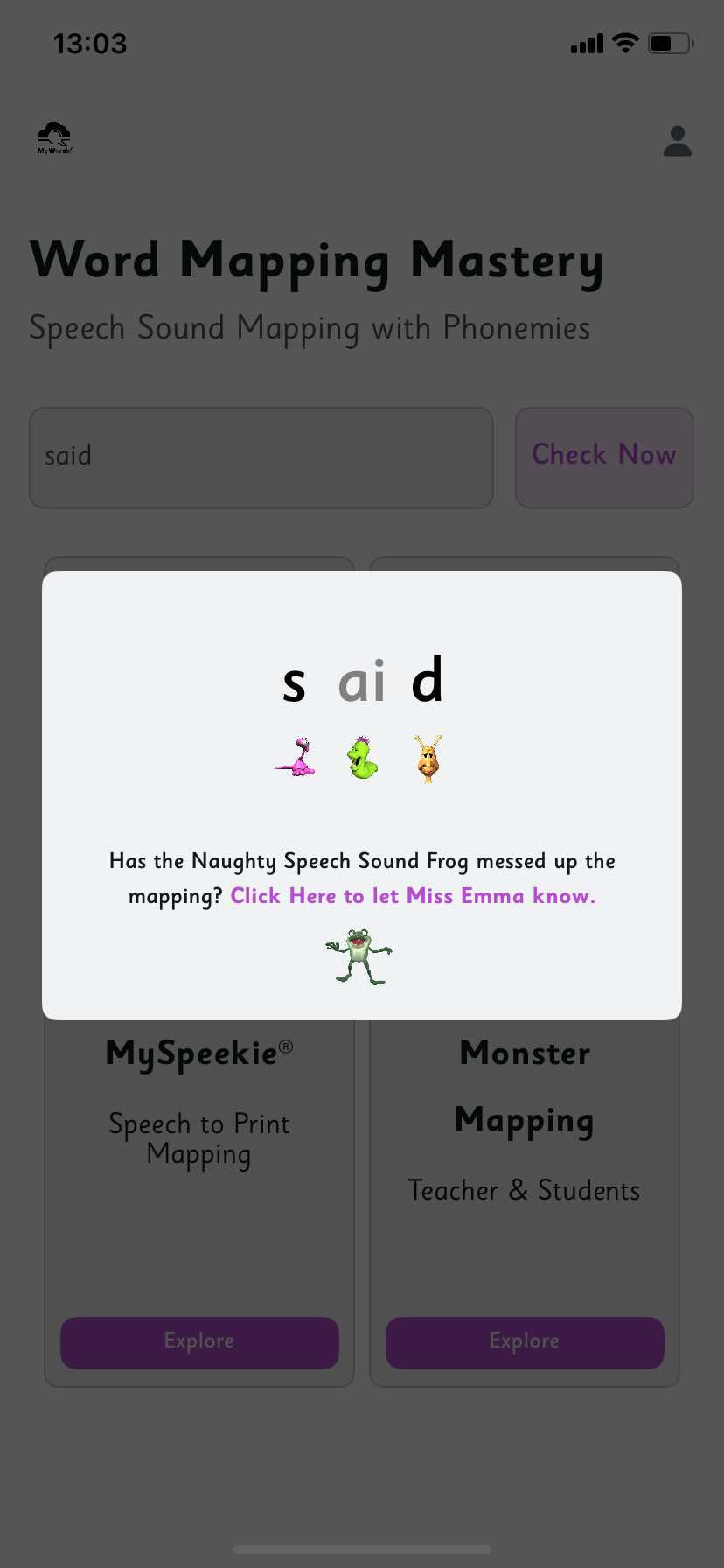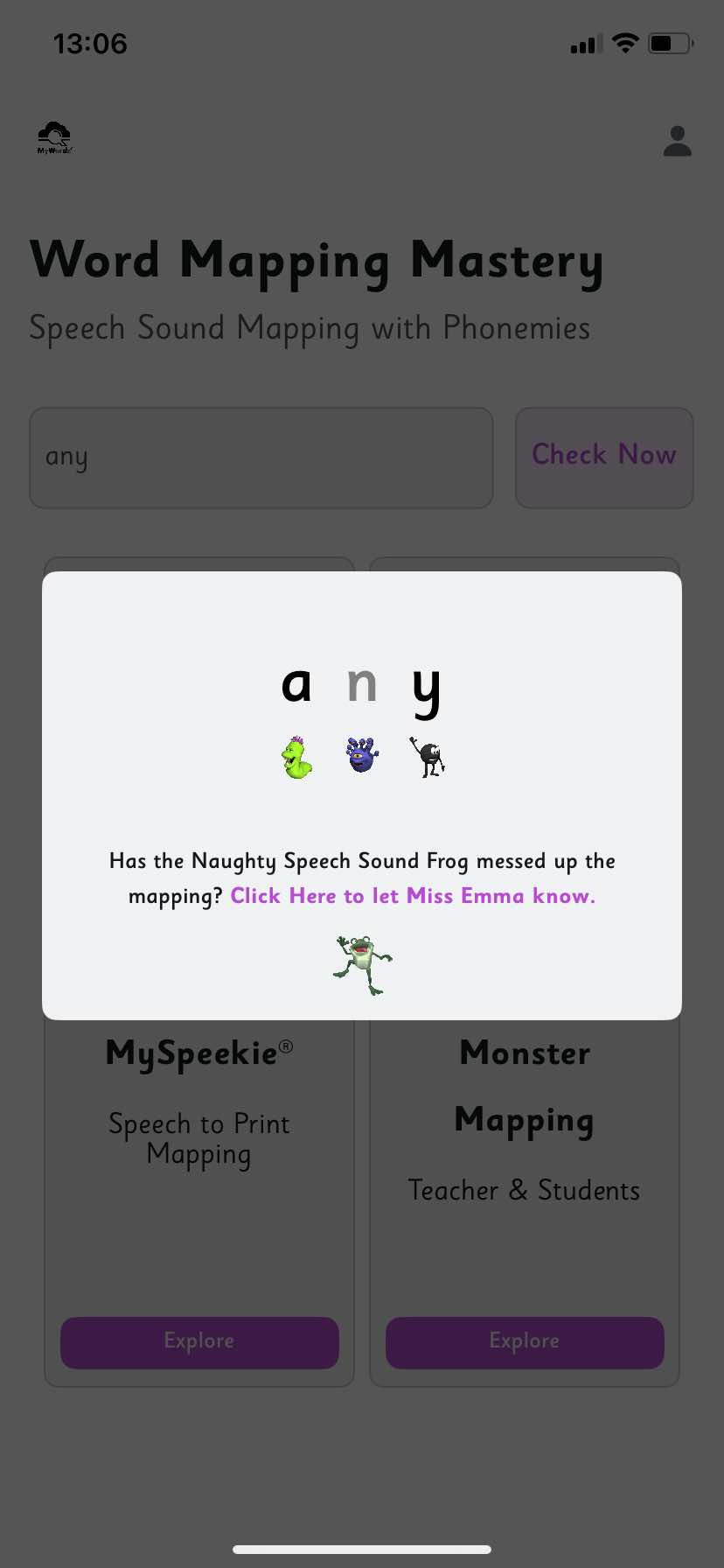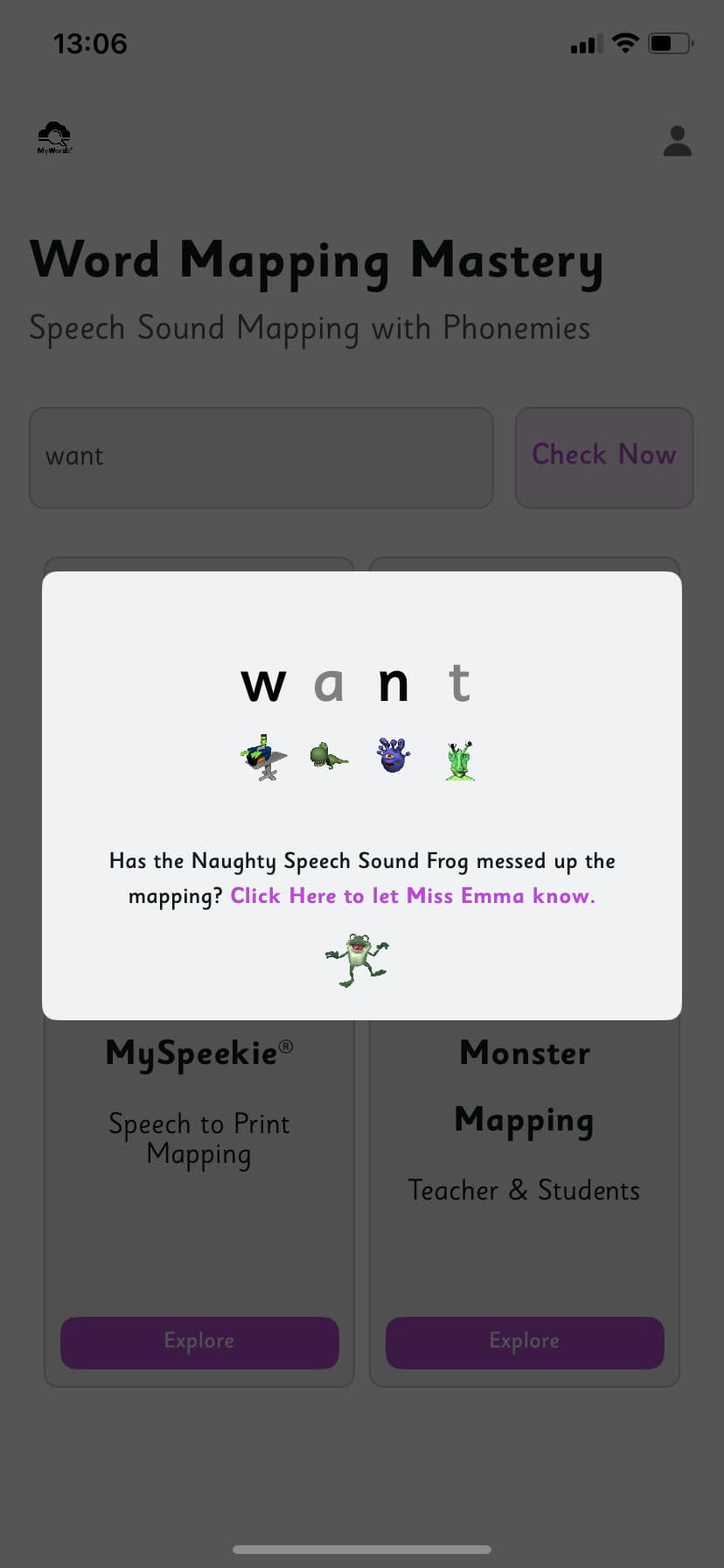Word Mapping Mastery®
"Show the Spelling Code!"
Exciting News! The Free Early Dyslexia Screening Centre has now opened in Dorset, with more planned nationwide.
Let’s support NeuroReadies: different learning needs different teaching. Tutor Course Speedie Readies: Preventing the Dyslexia Paradox

ANYONE can be a Word Code Mapper with MySpeekie®!
The quickest way to get children interested in learning to read and spell because it 'just makes sense' to them!

Speech Sound Mapping: Discovery Learning in Mind
Every child needs orthographic knowledge—an understanding of how letters and speech sounds connect—but traditional phonics instruction doesn’t work for everyone, especially those who struggle with rigid, adult-led teaching. Children learn best when they are engaged, curious, and in control of their own learning.
Our technology makes graphemes and phonemes visible, word mapping intuitive, and orthographic learning self-directed, allowing all children to reach the self-teaching phase faster and with less frustration. By giving them the tools to explore reading and spelling on their own terms, we’re transforming how children learn—without reliance on adult instruction.
The Code Mapping Tool makes graphemes visible, and Phonemies show sound values—empowering children to explore any word that interests them. This really matters.
Emma Hartnell-Baker has identified the minimum explicit phonics instruction needed for school-age children to start self-teaching. With our tech, teachers can achieve this at scale with a whole class. In the early years, this initial phase is often not needed at all!
Not sure what’s happening, but I’m absolutely inundated with “Getting Started” requests from Aussie schools! Has something happened that I’m unaware of?! lol
For Australians, the shop is https://speechsoundpics.com.au
Since there’s much more to SSP than phonics, https://wordmappingmastery.com was launched last year to support children from birth and offer specialist advice for neurodivergent learners and older students who have become instructional casualties.
We don’t so much have a SEND crisis in England as a “teachers are being told to use one-size-fits-all phonics and teach from the front” crisis. One in three children struggle, and one in four can’t read at minimum levels by age 11. Ironically, the amount of explicit phonics instruction doesn’t align with the science of reading.
The goal is to give children a kickstart so they begin self-teaching. We use tech to make that happen, freeing up the teacher. The tech addresses linguistic and neurodiversity within a classroom setting—something a human alone simply can’t do. Different phonemic awareness, accents, vocabulary knowledge, interests, and ability to sit and listen when bored… all vary widely.
This is how the Speech Sound Pics (SSP) approach was designed and why we use tech (ICRWY Lessons app) to teach phonics content. Everything covered in a synthetic phonics programme is learned at each child’s pace through tech, completing it in half the time.
With tech, explicit phonics instruction should only be needed in Reception, as it’s like having 25 teachers working 1:1 with children. It’s delivered within an evidence-based 30-minute routine that incorporates spaced repetition and other key learning principles.
By 2030 we can have 95% in England reading before KS2 if we stop asking teachers to teach phonics in a whole class setting. They’re 5 year olds! And even if they start school in nappies you can bet they can navigate an iPad. Schools are already covering the required phonics kickstart - they just need to stop doing that part with humans.
The book is available online for those who have completed training and will soon be available for rental to others. Thanks to everyone helping with editing—it’s a huge task!
Under the Training section, you’ll find video clips of all activities—accessible to everyone. Just sign up.
The Tech section showcases the latest tools, including:
• The Monster Spelling Piano for tablets, which builds on the original Spelling Piano app but now includes over 100 high-frequency words.
• The ICRWY Lessons app, available via monthly subscription for parents or a yearly school licence. It hasn’t changed—just expanded with more content. Essential not just for phonics content (GPCs and Duck Level videos) but also for Monster Mapped books, which start at the end of Purple and progress through 150 books to independent reading.
• The new MyWordz tech, which allows children to type words to see the Sound Pics and Monsters. They can also use the MySpeekie keyboard to see the correct spelling of words as they type. Use Map & Drag to print names eg ‘Stephanie’ shown below, labels, and spelling words (if you have to send home lists).
The handbook (15 chapters, with the Speech Sound Pics approach as just one part) will be available for rental from the end of next week.
You’ll need:
Monster Spelling Piano app
https://www.wordmappingmastery.com/monster-spelling-piano... – £4.95 per year - use across all devices with your account.
ICRWY Lessons app
https://www.wordmappingmastery.com/icrwy-i-can-read...
• £4.75 per month (parent subscription)
• £75 per year for schools (up to 25 devices, with options for more)
Essential for:
• Phonics content tested in the Phonics Screening Check (PSC)
• Over 400 orthographically mapped high-frequency words
• Monster Mapped 1,2,3 and Away! books (36 pre-readers for Yellow Code Level + 16 follow-ons, likely used at Blue level)
MyWordz Tech
https://www.wordmappingmastery.com/myspeekie-one-screen-aac
• £134.99 one-off payment (app usable across multiple devices with the same Apple/Google Play login)
• £75 per year for the web version (accessible on any device via https://mywordz.tech)
• Optional: Purchase additional app codes for £5.75 each when logged in.
Let me know if you have any questions?
Miss Emma x


Speech Sound Mapping: Discovery Learning in Mind
When you show the code, you don't need to 'explicitly teach' the concepts—the 'Code Mapping®' (black/grey to indicate the Sound Pics®/graphemes) plus the Phonemies to show the sound value just make sense to children's brains.
Word Mapping Mastery!
Build words and whole sentences with the 'Phonemies' keyboard! Including high frequency 'exception' words!





We create tech that facilitates 'less teaching, more learning'
Download the MyWordz® with MySpeekie® app – one-time payment of £134.99 – use across devices with your Apple or Google Play account.
Subscribe to the web version – log in at MyWordz.tech to use on any laptop or device through the website. 1 login: £95 per year.
Bonus! As a subscriber, you can purchase app licences for £5.75 per app.
Purchase within your MyWordz® account, and you will receive a code to redeem when you download MyWordz® for Members from the App Store or Google Play. A link is provided within your account.
Simply renew or cancel your web site login subscription every 12 months.
Current Special Introductory Price – £75 per year!
Australian schools can request to order the web version via purchase order and pay an Aussie business with an ABN (GST applies). Email Play@MyWordz.com for details.
Word Mapping Mastery!
Use the tech to create resources your child will find engaging!
By introducing 'word mapping' from birth, you can prevent children from entering an education system in England that mandates synthetic phonics—a system not designed for those with language processing challenges. This proactive approach helps avoid children becoming instructional casualties who—despite their best efforts—may never achieve even the minimum expected reading levels by the time they leave primary school.



